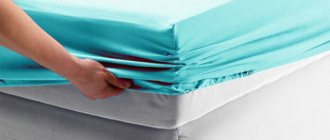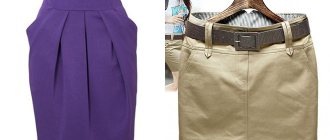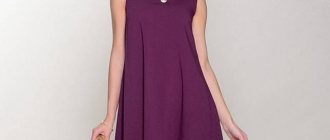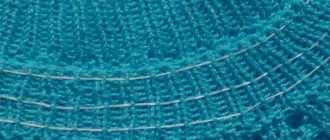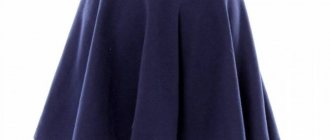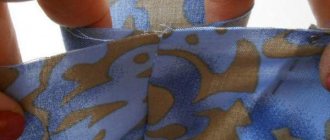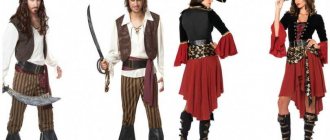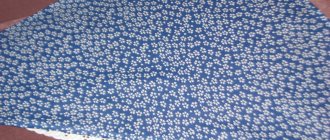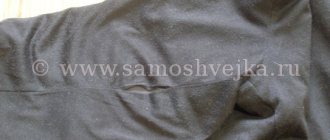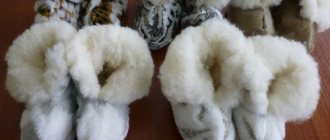Everyone has probably already heard, and more than once, about such a bed attribute as a sheet with an elastic band. Someone, wanting to get all the benefits from using it, goes to buy it at a bed linen store, while others think about how to sew a pillowcase, duvet cover or fitted sheet with their own hands.
There is a lot of information on this topic on the Internet. All of it is presented in different forms, which are sometimes difficult to perceive, both visually and informationally.
We will try to convey step by step, in illustrated form, information about the simplest method of sewing a sheet with an elastic band, from our point of view, with an explanation of each step. By the way, you can achieve your goal even without having an overlocker at hand. One sewing machine is enough. Well, of course, you also need scissors, a good quality elastic band (preferably 7 mm), plain threads and a measuring tape or ruler.
Let's consider this method using the example of sewing a standard version of a sheet for a mattress size of 87 cm by 194 cm with a height of 20 cm.
We immediately determine the optimal size of the sheet for our mattress, taking into account possible shrinkage of the fabric after washing.
For a mattress measuring 87x194x20 cm, taking into account the fact that we will sew from calico, the optimal size of the sheet will be 90x200x20 cm.
You can calculate the size of the sheet for your mattress, taking into account possible shrinkage, here
PS: If the fabric is first washed after purchase, the size of the sheet will correspond to the size of the mattress. In this case, shrinkage can be neglected.
We also note that this algorithm involves sewing a sheet from one single piece of fabric.
For reference: For the most popular sheet width of 220 cm, it is possible to sew sheets using one piece of fabric, only for a mattress width of up to 140 cm. For mattresses with a width of more than 140 cm, with such a sheet width (220 cm), the sewing algorithm will be different. More details on cutting a fitted sheet made of 220 cm wide fabric can be found here.
What to do if the sheet slips on the mattress
If during sleep, the sheet constantly slides off the mattress, this indicates that the cover on it is not natural
. Such fabrics are often used in the manufacture of economy-class products. Synthetic fabrics have a longer service life and lower price. The only and very important disadvantage is the sheet slipping.
Some time ago, many people solved this issue with the help of a thin cotton mattress, which was arranged on top. Also, we were able to find photos of various laces and drawstrings to secure the sheet. Agree, such methods are very labor-intensive and unreliable...
Currently, experts are offering a more practical solution to this problem.
- When purchasing a mattress with synthetic material, do not forget to purchase a sheet with an elastic band or a protective mattress cover
. It will hold your bedding in place and ensure a comfortable and restful sleep throughout the night.
- A sheet with an elastic band
is a profitable and inexpensive solution to the problem, and will also reliably protect the mattress from contamination and the penetration of pathogens.
- There are situations when a sheet with an elastic band does not help. In this case, you can solve the problem with the help of a thin mattress
made of natural materials. The width of the mattress cover should be no more than 5 centimeters. This product should be heavy so that during sleep the product does not slide on the synthetic material of the mattress. Experts recommend choosing luxury products. In their production, natural materials are used, such as cotton, knitwear, cotton jacquard, and polycotton.
Preparing tools for DIY sewing
Necessary tools and accessories:
- sewing machine;
- scissors;
- safety pins;
- fabric and threads;
- tape measure;
- sewing needles with a head at one end.
Video - Step-by-step master class on sewing a sheet with an elastic band
In addition, you will need an elastic band with a width of 0.5 cm.
For high-quality finishing of seams you need an overlocker
Familiarization with the rules for processing seams and edges
Modern sewing machines have an overlocker. But he processes the seam insufficiently and slowly. This device is suitable for thick fabrics. For lightweight materials, it is preferable to use a stand-alone option.
Main advantages:
- through cutting off the edge, the fabric is aligned;
- creating a roller seam;
- design of smooth connecting elements.
The machine secures the edge using a zigzag stitching method. This occurs due to differential feeding of textiles. Simple models do not have such a function. The use of this technology significantly extends the service life of the product. For reliability, you can start the connecting stitch next to the overlocker. Using a linen seam does not give the product a neat appearance. It will stand out greatly, especially in the corner elements.
Attention! The optimal stitch pitch is medium. Too small gaps negatively affect the quality of the product. When a needle pierces fabric with great frequency, it destroys its fibers.
Correct edge design
A strong elastic band becomes weaker after washing. It is not advisable to apply such material to the edge of the hem. It is preferable to insert in a circle. In this case, it can be tightened if necessary, which will certainly be required after several washes.
If you need to sew this element with a zigzag along the edge, use a special foot and sew it with a large line spacing. Otherwise, the elastic band will lose its elasticity due to frequent punctures.
Example drawing for a small bed
Sewing pattern, step-by-step instructions
Sewing machine prices
Sewing machine
Recommended sequence of actions:
Step 1. Measure the height of the mattress + 20 cm and make markings. Draw a square in the corner of the canvas.
Making the markings
Step 2. Cut out the square and repeat this step with the remaining 3 corners.
Cut out squares at the corners of the fabric
Step 3. Connect the cut sides of the squares and bend the fabric. Make sure that the front side is inside.
Connecting the cut sides
Step 4. Pin the connecting areas with pins. Make stitches in the corners, leaving a 1 cm allowance.
We make lines in the corners
Step 5. Fold the edges 1.5 cm. If you use a regular sheet for sewing, skip this step.
If necessary, bend the edges
Step 6. Fold again 1.5 cm and pin. Run a line around the perimeter. Leave 2.5 cm wide unstitched holes on the sides of each corner. They are needed for the elastic.
Don't forget to leave holes for the elastic
Step 7. Cut 4 pieces of elastic 35 cm long. Insert one piece into the corner of the product and pin the end at the hole. Attach a safety pin to the second edge. This will help thread it into the corner. Stretch the elastic and pin at the second hole.
We stretch the elastic band
Step 8. Sew the braid on both sides. Repeat with the remaining 3 corners.
Sew on the braid
Pro Tips:
- Before sewing, it is advisable to decate natural fabric. The fabric is soaked in hot water without using washing powder, dried and smoothed with an iron.
- It is more convenient to make the pattern on fabric. The design is simple and a minimum number of lines are applied for marking.
- The material should be swept in the corners to the full depth of the mattress. After stitching, it looks like a cover.
There are 4 known ways to fix an elastic band.
Finished stitching with sewn in elastic
Table 3. Methods for fixing the elastic band.
| № | Description |
| 1. | Fold the edges of the fabric around the perimeter and sew an elastic ribbon on top. |
| 2. | Secure the clasps at the corners. For a more durable fixation of the product, you need to use the transverse version. In this case, it is allowed to reduce the fold of the sheet by 5 cm. |
| 3. | Make a drawstring around the perimeter of the fabric - a seam with a hem. An elastic band equipped with a safety pin is threaded into this element. The ends of the braid are carefully secured. |
| 4. | This method is suitable for housewives who have good experience in sewing. On each side you will need about 20 cm of elastic, which is inserted only at the corners of the sheet. The edges of the fabric are folded by ironing and basting. An elastic band is inserted into the hem and connecting seams are basted. Then they are sewn on a sewing machine. |
The first and third methods are distinguished by their ease of implementation and difficulty in smoothing the product.
If you have a sewing machine at home, making a sheet will take several hours. You just need to check the correctness of the calculations and carefully make the connecting seams. A competent choice of fabric will extend the service life of the product and facilitate the process of washing and ironing.
Also, pay attention to this question: how often should you change your bed linen at home?
The main reasons why the sheet slips off the mattress
Let's start with the most common and main reasons why the sheets on the bed slip:
- Constantly change positions during sleep: fidget, move your legs and arms, roll over from side to side.
- The size of the sheet is not suitable for the mattress: the sheet must be significantly larger than the mattress itself in order to be able to remove the loose edges. Shrinking fabric is much easier than vice versa.
- The material of the sheets is incorrectly selected: thin synthetics, satin and silk, do not quite fit, they glide very well, and in hot weather or with heavy sweating, they can stick to the body. This means that you need to choose a sheet from more natural materials: cotton, calico, jacquard.
- You make the bed poorly or incorrectly: you leave free edges and do not put them under the mattress.
- The mattress consists of eco-friendly smooth materials: old mattresses with cotton padding or springs were not the most comfortable. But they did a good job of holding the bed linen, which cannot be said about the new orthopedic lightweight mattresses, which are mainly made of sliding materials.
Sewing bed linen with elastic, size 160 x 200 cm
The technology for sewing bed linen measuring 160 x 200 cm is no different from that described above.
Manufacturing process:
- Decate the fabric. Experienced dressmakers recommend lightly starching it additionally.
- Create a pattern directly on the fabric. To do this, add 30 cm on both sides to the width and height of the mattress. You get a rectangle with sides 220 x 260 cm. The resulting part is folded in four.
- Build a square with a side of 30 cm in the corner and cut it out.
- Place the edges of each cutout right side inward and stitch with a double seam.
- Turn out the corners. Iron.
- Double hem along the edge.
- Attach the elastic in one of four ways.
The nuances of making euro size sheets
The algorithm for making linen for a mattress with Euro dimensions, of course, does not differ from sewing sheets of other sizes, but there are still some nuances.
Experienced needlewomen know that the width of a roll of domestic calico is 220 cm, and for a sheet with dimensions of 200 x 200 cm (euro), you need to build a square with sides of 290 x 290 cm. There is only one conclusion - one of the sides will have to be enlarged.
In order not to spoil the overall appearance of the sheet, it is better to place the seam at the top of the bed linen. This way he will hide from prying eyes under the pillows. Due to the presence of seams, you should not choose fabrics with complex and large patterns. It’s great if it’s a plain material or with a small print.
Advantages and disadvantages
A lot of positive reviews on various forums and websites indicate a large number of advantages of such bedding over regular ones. The advantages of buying or sewing sheets of this design include the following.
- The fitted sheet does not move, crumple or get tucked under the person’s body, even if he actively moves in his sleep. This is especially true for children and adolescents, as well as adults who have restless sleep. In this case, the material of the linen does not matter: even a silk sheet will not move or bunch up.
- It is much easier to tuck the mattress with such a sheet, since it will always fit in size and does not need to be pressed on the sides to secure it. During operation, you do not have to remake the bed every day and you need to change such linen less often, since it does not wrinkle and gets dirty less often.
- It can act not only as a regular bed, but also as a mattress cover, protecting it from contamination. Cleaning a mattress is not an easy task, but such a cover will allow you to do it much less often.
- A mattress covered on the sides with an even stretched sheet looks much neater and more comfortable than usual. You can choose bedding to match the color of the bed itself or, conversely, a contrasting shade. Various patterns and ornaments along the edge of such a made bed look beautiful.
Unfortunately, for all its advantages, such an unusual idea is not without certain disadvantages. One of the main concerns of buyers about such a sheet is the difficulty of caring for it.
- Washing by hand is very labor-intensive and time-consuming, and the washing machine too quickly renders a tight elastic band unusable. This problem can be solved using various water softeners. These could be special tablets for washing machines or fabric softeners. In addition, during washing, small items tend to get stuck inside the sheet. To avoid losing a pair of socks or a small scarf, just turn the fabric inside out after washing. Or simply do not put such small things in the machine when washing bed linen.
- The second problem is ironing the sheet, since the elastic band tightens it and does not allow the sheet to be ironed thoroughly. The solution is quite simple. You should pull the sheet onto the ironing board with one hand so that the corner straightens. In this case, the iron is located in the second hand and easily passes through all the folds, straightening them. In addition, such a sheet can be ironed by pulling it over the mattress itself. After such ironing, you don’t even need to reposition it; it will lie correctly in the right place.
Both of these disadvantages can be considered conditional, since after two or three washes of the sheets, any person will get the hang of both washing and ironing such bed linen. However, all the benefits of using it will not disappear.
Most families who switched from regular sheets to fitted sheets no longer return to regular sets, as they find them completely uncomfortable.
How to sew an elastic band to a sheet at the corners
This method of attaching an elastic band to a sheet is convenient and more economical.
Despite the apparent complexity, performing such processing will not be difficult for a person who has at least some sewing skills:
- Make a hem along the edge of the sheet. Make amends.
- Sew by machine.
- Set aside 20 cm from each corner and mark. Thread the elastic band and secure it in the designated places.
- Additionally, stitch the corners with an elastic band inserted.
Orthopedic mattress covers against sheet slipping
Among the wide range, an excellent option for solving the problem of “slippery mattress” would be the “Lonax Memory” orthopedic mattress cover. The unique Memory Foam layer easily helps solve the problem of sheets slipping on the mattress. Memory Foam is an innovative material that quickly remembers anatomical shapes and makes sleep as comfortable and enjoyable as possible. The mattress cover is made without glue, so even people with allergies can use it.
Another popular option is the latex mattress cover “Lonax Latex 3”. This product serves not only to prevent sheets from slipping, but also to increase the service life of the main mattress, ensure comfortable sleep, and protect against the development of bacteria that negatively affect the human body.
Shape and dimensions
Children's products can be oval or even round in shape. For adults, a rectangular sheet is most often sewn in the shape of a mattress. Dimensions (in cm):
- 120x60;
- 60x120;
- 160x200;
- 90x200.
To determine the amount of fabric, you need to make a calculation. To the length of the mattress (200 cm), add 2 lengths of the sides (40 cm), add the fabric to the elastic and backing (20 cm). The width is calculated as follows: the width of the mattress (160 cm) plus two lengths of the sides (40 cm) and the fabric for the elastic and backing (20 cm).
Why does it crumple
Even if you take a large canvas and tuck it tightly under the mattress, in the morning you will note with regret that it crumpled during the night and exposed part of the sleeping area. And it doesn’t matter what kind of mattress you have: orthopedic, foam rubber, cotton or spring.
The sheet will bunch up on any of them unless you take immediate action. You will have to use fasteners or replace the fabric.
It can crumple for various reasons:
- too short in relation to the mattress;
- too slippery;
- too thin.
Also, the cause of wrinkling during sleep can be a slippery mattress and too active tossing and turning of the sleeping person at night. The first problem can be solved by purchasing a special mattress cover on which the laundry will not slip. And you can hardly make a tossing and turning person sleep peacefully, so you will have to use additional things.
Benefits of using fitted sheets
The secret of the ever-increasing interest in fitted sheets is its convenience. After all, it does not slide off the mattress, does not bunch up, even if the sleeping person tosses and turns very intensively all night. It is easy to refill. A bed with such linen looks neat, as if it had just been made. In a word, not a thing, but just a godsend for lovers of order.
Corner fasteners
Among the various elements of bedding, there are special fasteners that look like trouser suspenders. These products may consist of metal or plastic clips. The former are more expensive, but their service life and reliability are an order of magnitude higher than their plastic counterparts. The fastening elements of the clamp grip the sheet on both sides of the mattress. And the thick elastic band that connects the clips keeps the “braces” in one place.
How to make a hem
The lower part of the mattress cover provides tension, and the degree of fixation of the product depends on its width. Lengthening the hem for a sheet increases fabric consumption, which is not always justified. A fabric strip of 10-15 cm can hold the product more reliably than a 50 cm one. Beginning craftswomen are advised to sew a sheet with a minimal hem and a partially tucked elastic band, so as not to complicate the process.
On a children's mattress, the sheet will be held in place with a fixing part 5-7 cm wide. For single and one-and-a-half berths, it is worth lengthening the hem fabric to 10-15 cm. It is better to cover European standard mattresses with a mattress pad with a hem of 35-50 cm.
Elastic adjustable clamp
The device consists of an elastic band with a slider and two clips (metal or plastic). Using the slider, the length of the elastic is adjusted so that the cover fits snugly to the mattress. The only drawback of such a product is the inevitable wear of the rubber cord (due to constant tension).
An easy way to fold a sheet
Owners of fitted sheets know their only drawback: such linen with an elastic band is extremely difficult to fold. Having suffered once, twice, most often after washing the sheet is sent in an untidy heap to the linen closet. However, there is a way to neatly and easily fold mattress covers.
To do this, you first need to turn the sheet inside out. Place your hands in the corners.
Then put the corner from the right hand onto the left, turning it inside out at the same time. Do the same with the bottom corners.
Straighten the sheet.
Again, transfer the corners from the right hand to the left, turning them inside out at the same time.
Lay out the laundry on a flat surface.
Now the sheet can be rolled in three stages.
First time
Second time
Then proceed as with a regular sheet.
What are they?
In stores you can find fitted sheets and even entire sets of bed linen in a variety of shades and patterns. These can be either plain pastel-colored canvases or real works of art. Children's sets with various cartoon and fairy-tale characters stand out especially brightly against this background.
But you can classify fitted sheets not only by their design, but also by other parameters. Based on the fabric composition, you can find the following products:
- calico sets;
- percale sheets;
- poplin bed linen;
- knitwear;
- silk or satin sets;
- warm terry options.
Almost all options, except silk and satin sheets, use cotton thread. The only difference is its thickness and the method of weaving. People whose skin is especially sensitive and prone to irritation should not take synthetic sets.
The choice of artificial material for a child's bed will also not be the most successful.
Depending on the size, underwear is divided into the following types:
- 120×60 – this size is considered for children;
- 200x90 or 200x80 are sets for a single bed;
- 200×110 and 200×120 – single bed linen;
- 200×140, 200×160 and 200×180 – for a double bed;
- 200x200 is a standard size called “euro”.
In addition, stretch sheets may differ in their design.
- An elastic band can be sewn around the entire perimeter of the sheet, making it a kind of bag.
- Elastic can only be sewn into the corners of a rectangular fabric.
- The elastic can be in the form of a ribbon, sewn on both sides of the corner of the sheet and placed on the mattress like a strap.
Sewing technology with clasps
Clasps are transverse elastic fasteners. Externally they resemble trouser suspenders. The sewing technology is standard for a sheet with an elastic band. Clasps hold textiles on the mattress on all sides; there are angular and transverse ones.
The calculation rules, pattern making, technology for sewing a sheet with an elastic band, and fastenings to the mattress are identical and the same for all sizes. Use step-by-step instructions, take into account the individual dimensions of the sleeping place for calculations, follow the sewing technology.
Types of holders and fastenings
To prevent the sheet from crumpling, it is attached to the mattress using holders.
Special holders
In order to prevent crumpling and gathering of bed linen, specialized triple fastenings are used. They are strips of durable fabric connected in the shape of the letter T. At the end of each of them there is a clip. The central one is attached directly to the corner of the sheet, the two adjacent ones are attached nearby. In this case, the fastening is positioned in such a way that all its parts, except for the clamps, are located under the mattress.
The advantages of such fasteners include efficiency. The disadvantages are an unattractive appearance (the clips often stick out) and an increased load on the bed linen, which significantly reduces the service life of the textiles.
Crocodiles
Also, in order to secure the sheet, tension tapes with fastenings called “crocodile clips” are used. They are placed right in the middle of the mattress, they go right under it. In this case, the “crocodiles” are attached to the edges of the linen. Usually 3 - 4 tapes are used. This ensures maximum fastening efficiency. If necessary, use more.
The main advantage of this type of fixation is its high reliability. If the tapes are properly tensioned, the fabric will probably not move anywhere. And the main disadvantage of the method is increased wear of textiles. The fact is that “crocodiles” violate the integrity of the fabric, as a result of which small holes, barely visible to the eye, appear on it. Because of this, the service life of the product is significantly reduced. At the same time, a damaged item that has been badly worn by clamps is unlikely to be repaired later.
Double clamps
They are an analogue of triple clamps, but they are attached not to the corner of the textile, but to the sides of it. The main advantage of this approach is the reduced load on the fabric, which significantly reduces wear. But there are also disadvantages. Since there was one less tape in the mount, it became worse to hold. When using a double clamp, the corner of the sheet often becomes puffy, as a result of which it has to be tucked under the bed quite often.
Available means
Most often, housewives make holders themselves. Here are the most common varieties that you can make yourself.
- Rubber. The simplest and cheapest option. The elastic can be sewn in two ways. The first is creating loops at the corners. They are thrown over the mattress, thus firmly fixing the linen. The second method is to place the elastic along the edges of the sheet. It is important that the product is significantly larger than the mattress and is able to wrap around it. In this case, the sheet is pulled like a cover. The advantage of elastic bands is their low price and ease of fastening. The main disadvantage is that after a certain time it stretches and loses its original properties.
- Stationery clips. Some types of mattress covers allow you to secure the fabric using paper clips. The main advantage of this method is its very low cost and incredible simplicity (you don’t even need to sew anything). However, it also has some disadvantages. There are two main ones: insufficient reliability and not very pleasant appearance.
- Curtain clip. In order to secure textiles, “crocodile clips” are used for curtains. This method is similar to the previous one and has all the same advantages and disadvantages. However, a curtain clip provides a more secure hold. Plus it's much easier to hide.
- Clothespins. Essentially, the method is similar to the previous one. But here, instead of curtain clips, plastic clothespins are used. The good thing about this method is that it causes less damage to textiles. Otherwise there is not much difference.
- Buttons. The essence of the method is simple: buttons are sewn to the mattress along the entire perimeter, holes are made in the sheets, and then they are stitched. As a result, both objects can be fastened to each other, in which case slipping is excluded. The advantages of the method are simplicity and low cost. The main drawback is that the buttons come off from time to time. This happens especially often during washing.
- Loops. Loops are sewn along the edges of the fabric (a pair from each corner). When making the bed, they are tied so that they tightly hug the mattress cover. As a result, the laundry does not slip. The advantages of the method are simplicity and low cost. The disadvantage is that the loops put a certain amount of stress on the sheet and can even tear it.
Sewing oval and round sheets
Sometimes you need to sew a sheet for an oval or round bed.
As with rectangular models, before work, measurements are taken from the mattress: height, width and length.
For example, we got the following dimensions:
- height - 16 cm;
- length - 125 cm;
- width - 75 cm.
How to sew:
- Cut out a rectangle of fabric 80 x 130 cm.
- Fold in half, then in half again. From the top of the outer corner, set aside 24 cm in both directions. Draw a smooth line through the points, rounding the corner.
- To create a facing pattern, you will need two quantities: length and height. To calculate the first, you need to sum up the lengths of the sides of the rectangle: 80 + 130 + 80 + 130 = 420 cm. For the second, add 5-6 cm to the height of the mattress per hem: 16 + 5 = 21 cm.
- Cut a rectangle from the fabric with dimensions of 420 x 21 cm. If the fabric does not allow you to make a solid side, you can break it into several parts. In this case, several strips are cut out taking into account a seam allowance of 0.5-1 cm.
- Place the side part on top face to face and stitch.
- Connect the edges of the facing. Trim off excess.
- Overlock the edges or use a zigzag stitch.
- Fold the edge of the facing one centimeter and iron it. Repeat again.
- Sew around the entire perimeter, leaving a small section unsewn - 1-1.5 cm.
- Thread an elastic band into the drawstring and sew the ends together.
The fitted sheet for the oval mattress is ready.
A round mattress cover is sewn in the same way.
Manufacturing process:
- A circle is cut out of the fabric, the diameter of which is equal to the diameter of the mattress plus 5 cm for seams and shrinkage.
- The length of the facing is equal to the perimeter of the cut circle plus a seam allowance of 2 cm.
- The height of the side is equal to the height of the mattress plus allowances for the seam and hem (drawstring) - 5-6 cm.
- You need to assemble the mattress cover in the same way as described above.
Fitted sheets made of jersey or satin
Making your own fitted sheets
Elastic is most often sewn onto knitted and satin sheets, since the thin or elastic fabric conforms to the shape of the bed very well. Satin and knitted fabric does not form wrinkles and fits perfectly not only to the surface, but also to the sides of the mattresses.
Factory fitted sheets come in different colors and are made from different materials.
Sleep is an important part of life; comfortable sleeping conditions allow the body to fully rest. Therefore, a well-fitting sheet, free of wrinkles and lumps, can have a significant impact on your overall well-being and health. A comfortable bed with well-secured linen is especially important for children.
Set of sheets with elastic for a baby's crib
In addition, the additional fixation of linen saves time that would normally be spent making the bed every day.
Using threads
To prevent the sheet from sliding on the mattress, it can be sewn on. To do this, the canvas is basted with large stitches around the perimeter of the mattress, thus fixing it on all sides. The advantage of the method is its high efficiency, but the disadvantage is that the process is very labor intensive, since the procedure will have to be repeated every time the linen is changed.
Using buttons
Unlike the previous one, this method allows you to securely attach the sheet to the mattress, only spending a certain amount of time once. Buttons are sewn in a circle to the mattress, after which a sheet is laid out and the places for the loops are marked. Then loops are made from strong elastic elastic and sewn to the sheet. Instead of buttons and loops, you can use a textile fastener or, as it is popularly called, Velcro.
However, it is worth considering that after several washes, Velcro partially loses its ability to adhere to the base, while buttons can last a very long time.
Stationery clips
Factory holders can be replaced with homemade holders made from a wide elastic band and paper clips. A significant disadvantage of office clips is their lack of teeth, which is why the fixation of tissue with their help will be much weaker.
Clothes pegs for curtains
Instead of office clips, you can use curtain clothespins with rings. To do this, small buttons are sewn to the mattress, curtain clips are hung on them by the rings and the edges of the sheet are grabbed with them. You can also sew the clips directly to the mattress using thin satin braid. The tape is threaded through the ring, a loop is made and it is sewn to the mattress. As a result, the sheet is clearly fixed with clips and does not move out.
Pins
You can attach the sheet to the mattress using pins with plastic caps. The canvas is spread out, leveled well and pinned around the perimeter to the mattress. A significant disadvantage of this method is the likelihood of injuring yourself on the point of a pin if it is accidentally unfastened.
In this connection, this method can be considered as temporary and used in hotels, sanatoriums and holiday homes.
How to choose material
Requires sheet linen, elastic or fasteners.
Main fabric
Due to the fact that during sleep the body comes into contact with the fabric for a long period of time, it should be pleasant to the touch and not contain harmful impurities. The following materials are considered the best:
- cotton;
- linen;
- silk.
They are hygroscopic, have a long service life and are easy to maintain.
Cotton is a very practical and budget fabric.
The material has unique qualities that have a positive effect on the skin. Thanks to its breathable structure, it promotes natural air circulation. Due to the absence of a greenhouse effect, even in summer, cotton underwear gives you a feeling of coolness. The fabric is sold in any textile store, washes well and is easy to iron. No additional accessories for the sewing machine are used during operation.
Cotton is an environmentally friendly product
Table 1. Main characteristics of cotton-based fabrics.
| Name, photo | Description |
| Calico | One of the most suitable options. With normal care the product will last a long time. Traditional cross-shaped weaving of threads ensures high strength of the material. |
| Batiste | Incredibly light, flowing, very pleasant to the touch fabric. Due to insufficient strength, it is not suitable for daily use. The fabric belongs to the expensive price segment and loses its characteristics after 20 washes. |
| Poplin | The term "poplin" comes from the Italian word "papalino", which means "papal". A popular option for sewing sleeping sets, in demand since the 14th century. The Pope loved to sleep on poplin sheets. The fabric is obtained by crossing thin vertical and thick longitudinal threads. The result is a material that is soft on the outside but strong on the inside. They are created on the basis of cotton, wool or silk fibers. |
| Cotton jersey | A category of fabrics represented by many varieties. They are differentiated by the method of processing threads and weaving technologies. The main difference is that the fabric is made not by weaving, but by knitting. By bending around each other, the loops create elastic fabric. |
| Percale | The fabric is produced by cross-weaving long fibers treated with a mixture. This impregnation strengthens the structure of matter. The composition is safe for health. The main characteristics are a velvety surface, a high degree of strength and good wear resistance. Since only fine or medium thread counts are used, the fabric is quite light. |
| Mahra | Practical and comfortable material that brings warmth and coziness to the sleeping area. Indispensable in cold winter. Does not wrinkle and washes well. When touched, the fibers bend elastically under the hand. The tactile sensation is reminiscent of velvet. You should not purchase terry that contains more than 5% synthetic impurities. It will be hard and wear out quickly. |
General recommendations for choosing fabric:
- Visual inspection. Low-quality material can be easily identified by gaps in the structure. Rare weaving of threads negatively affects strength. After 4-5 washes, the laundry will be worn out.
- Odor analysis. Good cotton fabric smells like textiles. Any chemical aromas indicate harmful impurities that contribute to the development of allergic reactions.
You should not buy fabric with protruding threads or raw edges.
Attention! Sewing requires 3 m of calico with a width of 2.2 m. Since this type of material shrinks after contact with hot water, 3 cm is added to the measurements.
Threads need to be selected based on the structure of the material
Sewing threads
Before purchasing sewing accessories, it is important to understand for what purpose it will be used. Based on their purpose, threads are classified into the following categories:
- for sweeping;
- embroidery;
- machine stitching;
- decorative seam;
- edge processing.
Within each variety they differ in length, composition, thickness and texture.
Table 2. The most common types of threads.
| Name, photo | Description |
| Cotton | Natural composition and inexpensive cost. To add shine, they are mercerized. Since they do not stretch, unlike their synthetic counterparts, they are used primarily to create decorative embroidery. |
| Polyester | They have good elasticity. Popular when sewing knitwear and stretchy fabrics. After numerous washes they do not lose their characteristics. |
| Reinforced | The base is a lavsan rod, which is incredibly durable. Made from silk, cotton or syblon. Due to their good stretchability and high strength, they are considered universal. |
| Silk | They are used not only for working with silk. The structure of the fibers allows them to be used for sewing woolen products. The threads are strong, beautiful, but expensive. Mostly they buy a cheaper synthetic analogue. |
| Nylon | Available in 2 varieties - monofilament or consisting of several fibers twisted together. The latter are characterized by the rigidity necessary for creating leather products. The first option is suitable for hemming and designing hidden lines. |
| Lavsan textured | A good choice when sewing knitwear. They have good elasticity and strength. |
| Metallized | An alternative name is Lurex. Produced in a variety of shades. The characteristic metallic sheen has led to its popularity in the decorative embroidery segment. |
Note! To work with cotton, you need to choose not thick, but strong threads. They should not deteriorate from being in a humid environment. Otherwise, holes will appear on the seams after a few washes. LH-45 threads are suitable for processing durable connecting elements
Regular braid is suitable for sewing the product.
Linen elastic
The quality of the rubberized tape determines its performance characteristics after numerous cleaning procedures. The latex thread present in it gives the product strength and elasticity. For sewing you will need about 5 m of elastic band.
Attention! To reduce material consumption, a wide elastic band, up to 3 cm, is fixed along the edge of the fabric. In this case, there is no need to create large allowances for hemming. In addition, the service life of the product increases, since thin braid stretches faster.
The cutting accuracy is determined by the equality of the diagonal of the sheet and mattress
How else can I attach?
To ensure that the sheet stays well on the bed, you can use the available tools that are available in every home. An elastic band, buttons, alligator clips for curtains, pins and paper clips will help keep the material on a slippery mattress.
Useful tips
To ensure that the sheet does not bunch up and that you have a restful and sound sleep, it is recommended to use simple tips.
- When fixing a sheet to a sofa, many available methods will not work. You cannot sew buttons, curtain clips or pins onto it. This is due to the daily disassembly/assembly of the sofa and the fact that sewn elements will spoil its appearance. In such a situation, only factory double or triple holders will help, which are able to fix the sheet even when the sofa is folded.
- When choosing bed linen, great attention must be paid to the fabric. It must be remembered that sheets made of denser material adhere to mattresses much better than thin models made of weightless materials. Moreover, dense fabrics made from natural fibers “breathe” better and therefore do not cause excessive sweating. As a result, the sheet remains dry, does not stick to the body and, as a result, moves less. The best choice would be to purchase bed linen made from thick calico, jacquard or regular cotton. It is better to avoid silk, satin and synthetic models: they have a slippery surface and stick to the body in hot weather.
- To prevent sheets from rolling off orthopedic mattresses, it is recommended to use mattress protectors. They are covers made of dense, rough fabric, the structure of which provides good adhesion to the sheet and prevents it from slipping. Among other things, a mattress protector protects the mattress from dirt and unpleasant odors, thereby increasing its service life.
Fabric for baby set
There are strict requirements for children's sleep accessories. They must be safe in terms of containing harmful substances and toxins, breathable and hygroscopic, and also have high heat transfer, providing the baby with comfortable conditions at any time of the year. In addition, it is important how easy the material is to care for, how quickly it dries and how much it wrinkles, how long it will last and whether it retains the brightness of the colors. For this reason, predominantly cotton fabrics are used to sew children's sheets:
- Chintz . Soft, cozy and safe for baby's health material that is suitable even for newborns. It stands out for its reasonable price and a wide selection of bright colors. Among the disadvantages: it fades over time and shrinks after the first wash.
- Calico . It allows air to pass through, absorbs moisture and does not create a greenhouse effect. Sets made from calico are bright and colorful, but rough to the touch, which is something mothers of babies with sensitive skin need to remember. The fabric itself is thin, so sheets made from it quickly become damaged due to constant washing.
- Ranfors . Similar to calico, but denser in structure, therefore more wear-resistant and durable. Soft, smooth and quickly absorbs moisture.
- Satin . Smooth and shiny fabric, similar to satin, but at the same time strong and durable. It is highly hygroscopic, practically does not wrinkle or shrink after washing, but is more expensive than other cotton materials.
- Tale . Warm and soft fabric from which most bedding for newborns is made. Retains heat well, absorbs moisture, and is easy to wash and dry quickly. Sometimes viscose is added to the fibers, but in this case the fabric is significantly inferior in terms of hygroscopicity, so for children's sheets it is better to use baize in its pure form.
- Mahra . Easy to care for, easy to wash, does not stretch, does not shrink and does not require ironing. It allows air to pass through well, allowing the skin to breathe, and absorbs water. But due to the special rough surface in the form of pile loops, it can be unpleasant for the delicate skin of a baby, so terry underwear is more suitable for older babies and teenagers.
